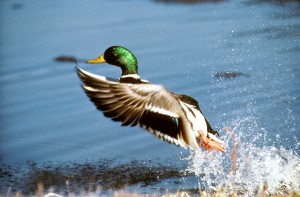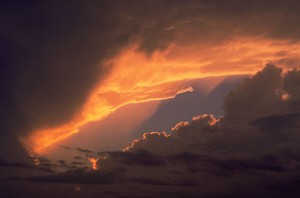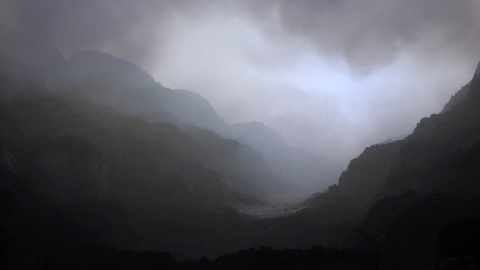It’s amazingly quiet at the upper end of the huge municipal park, furthest from the city center but still in town. A spot overlooking the stream is unoccupied, and I sit down with my back to the sun, surrounded by the first new foliage of spring.
 A pair of mallards, which apparently make their home along this stretch of the stream, nonchalantly drift downstream as I walk up, but stop in an eddy only 20 meters away. A quarter hour later, obviously feeling the human is ok, they paddle back upstream to clean, preen and sleep directly across from me.
A pair of mallards, which apparently make their home along this stretch of the stream, nonchalantly drift downstream as I walk up, but stop in an eddy only 20 meters away. A quarter hour later, obviously feeling the human is ok, they paddle back upstream to clean, preen and sleep directly across from me.
The green head of the male fluoresces in the sunlight, and the blue chevrons on his wings add the perfect touch to his startling colors. The brown and white speckled breast of the female looks very plump; she’s obviously ready to give birth to a new brood. The male turns its head nearly 180 degrees, tucks it into his back feathers, and goes to sleep.
Stupendous clouds of every shape, size and color scud across the sky. There are large gaps between them, so one minute the sun streams down through fleecy white formations with a backdrop of azure; the next minute dark and ominous masses pile together, looking as if they could send rain and thunder crashing down upon the earth.
The quietness penetrates and deepens; meditation begins. When thought yields to seeing and being, reverence spontaneously flows forth within one. Not reverence for nature per se, but for life and death, beauty and mystery within and beyond all of nature’s changing forms.
There can be no reverence for or from thought, even for its best processes and productions, anymore than there can be reverence for a bridge or a building, including the greatest cathedrals. Stillness of mind and emptiness of being are the sine qua non of reverence and love.
As a great religious teacher said, “without meditation the heart becomes as desert, a wasteland.” Negating the observer is always the starting point, but any effort to dissolve the mechanism of thought’s infinite regress only strengthens the separate self.
“The Cloud of Unknowing” is a classic of Christian mysticism, written anonymously in the 14th century, and still widely read in some circles, not all of them closed and cloistered.
read in some circles, not all of them closed and cloistered.
There’s a lot of contemplative nonsense in that little book, but there are a few gems like this as well: “Thought cannot comprehend God…you must set aside all knowledge and cover it over with a cloud of forgetting.”
Wikipedia describes “The Cloud of Unknowing” this way: “The underlying message of this work proposes that the only way to truly ‘know’ God is to abandon all preconceived notions and beliefs or ‘knowledge’ about God and be courageous enough to surrender your mind and ego to the realm of ‘unknowingness,’ at which point, you begin to glimpse the true nature of God.”
Only at the end of the hour do dogs bark and machines start up, marking the end of the sitting. Walking out one feels again the ‘unbearable lightness of being,’ but I’m quickly brought down to earth when I encounter three large dogs walking a trio of overweight people.
On the walk, an experience I had when I first moved to this town comes to mind. The edge of town was a mile from the apartment complex I had moved into, and the countryside was still quite wild. I would often see pheasants, various hawks (including those extraordinary hovering falcons, the kites), and would sometimes even catch a glimpse of a coyote.
 After sitting down one pleasantly familiar summer morning in the dry grass next to the creek, I heard something moving toward me. A few seconds later I saw it—a fat, four-foot long rattlesnake! For some inexplicable reason it kept coming directly toward me; my legs and arms became springs, adrenaline bouncing me off the ground like a jackrabbit.
After sitting down one pleasantly familiar summer morning in the dry grass next to the creek, I heard something moving toward me. A few seconds later I saw it—a fat, four-foot long rattlesnake! For some inexplicable reason it kept coming directly toward me; my legs and arms became springs, adrenaline bouncing me off the ground like a jackrabbit.
The snake stopped, stretched out to its full length in the grass. It didn’t coil, and it didn’t rattle. Then I did something that seems strange now but fitting then—I sat back down.
With the rattler only an arm’s length away, I sat there for a full hour. Fear dissipated, but I didn’t take my eyes off the snake for long. Attention, which grows intense during passive observation in nature anyway, intensified to a tremendous degree.
Walking back past school kids playing on green, manicured lawns during recess, I felt like I’d been in the wilderness for a week.
A few years later, I knew it was over for the wildlife in the area when I passed some schmuck, his young son adoringly in tow, proudly holding up a rattler he had just killed of the same size. ‘Why did you kill it?’ I foolishly asked, knowing the answer but feeling I had to say something. “Because it might have bitten my boy,” came the disingenuous reply.
A professor I talked with recently said that even his cat suffers from what he calls the ‘primal paradox’—that is, being both a separate individual and an inextricable member of a collective species. But that’s ridiculous; animals aren’t having a crisis of consciousness, except as man is visiting it on them.
There is only one way out for humans now—to grow into human beings. Content-consciousness has accumulated so much useless material that it has formed a black hole, at least where western civilization used to be, sucking all but the strongest into it.
But there’s a way out, and ahead. One can leave the stream of content-consciousness, if only temporarily each day, through setting aside time for passive but intense observation. Doing so, the content of consciousness (memories, emotions, associations and experiences–the whole movement of thought) ceases operating in the brain. Negating the known, one enters a consciousness of a completely different order.
Negation and meditation do not occur through effort or will, only through undirected watchfulness, which gathers tremendous attention and permits the clarity of unknowing.
Martin LeFevre

